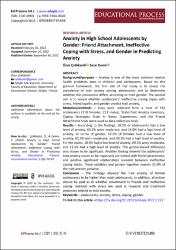| dc.contributor.author | Çelikkaleli, Öner | |
| dc.contributor.author | Demir, Sezai | |
| dc.date.accessioned | 2022-11-22T12:55:47Z | |
| dc.date.available | 2022-11-22T12:55:47Z | |
| dc.date.issued | 2022 | en_US |
| dc.identifier.citation | Çelikkaleli, Ö., & Demir, S. (2022). Anxiety in High School Adolescents by Gender: Friend Attachment, Ineffective Coping with Stress, and Gender in Predicting Anxiety. Educational Process: International Journal, 11(3): 32-47 | en_US |
| dc.identifier.issn | 2147-0901 / 2564-8020 | |
| dc.identifier.uri | https://dx.doi.org/10.22521/edupij.2022.113.2 | |
| dc.identifier.uri | https://hdl.handle.net/20.500.12809/10403 | |
| dc.description.abstract | Background/purpose - Anxiety is one of the most common mental health problems seen in children and adolescents. Based on this general framework, the first aim of the study is to reveal the prevalence of trait anxiety among adolescents and to determine whether this prevalence differs according to their gender. The second aim is to reveal whether adolescents' ineffective coping styles with stress, friend loyalty, and gender predict trait anxiety. Materials/methods - Data were collected from a total of 531 adolescents (318 females; 213 males). State-Trait Anxiety Inventory, Coping Strategies Scale in Stress Experiences, and the Friend Attachment Scale were used as data collection tools. Results - According to the findings, 18.3% of adolescents had a low level of anxiety, 65.2% were moderate, and 16.0% had a high level of anxiety. In terms of gender, 17.6% of females had a low level of anxiety, 62.3% were moderate, and 20.1% had a high level of anxiety. For the males, 18.3% had a low level of anxiety, 69.5% were moderate, and 11.3% had a high level of anxiety. This gender-based difference was shown to be significant. Another finding showed the adolescents' trait anxiety scores to be negatively correlated with friend attachment, and positive significant relationships revealed between ineffective coping styles. These variables and gender together explain 31.0% of the trait anxiety variance. Conclusion - The findings showed the trait anxiety of female adolescents to be higher than male adolescents. In addition, attention should be paid as to whether attachment to friends and ineffective coping methods with stress are used in research and treatment processes related to trait anxiety. | en_US |
| dc.item-language.iso | eng | en_US |
| dc.publisher | Universitepark | en_US |
| dc.relation.isversionof | 10.22521/edupij.2022.113.2 | en_US |
| dc.item-rights | info:eu-repo/semantics/openAccess | en_US |
| dc.subject | Adolescents | en_US |
| dc.subject | Anxiety | en_US |
| dc.subject | Stress | en_US |
| dc.subject | Coping | en_US |
| dc.subject | Gender | en_US |
| dc.title | Anxiety in High School Adolescents by Gender: Friend Attachment, Ineffective Coping with Stress, and Gender in Predicting Anxiety | en_US |
| dc.item-type | article | en_US |
| dc.contributor.department | MÜ, Eğitim Fakültesi, Eğitim Bilimleri Bölümü | en_US |
| dc.contributor.authorID | 0000-0003-0210-3647 | en_US |
| dc.contributor.institutionauthor | Çelikkaleli, Öner | |
| dc.identifier.volume | 11 | en_US |
| dc.identifier.issue | 3 | en_US |
| dc.identifier.startpage | 32 | en_US |
| dc.identifier.endpage | 47 | en_US |
| dc.relation.journal | Educational Process: International Journal | en_US |
| dc.relation.publicationcategory | Makale - Uluslararası Hakemli Dergi - Kurum Öğretim Elemanı | en_US |


















